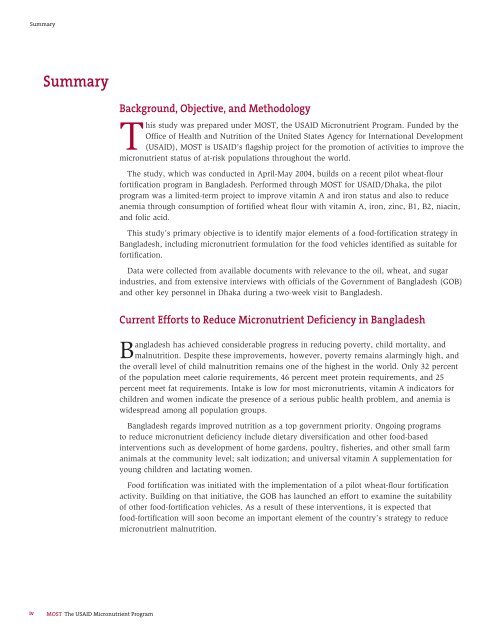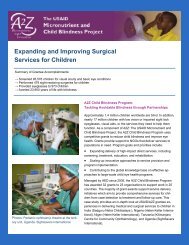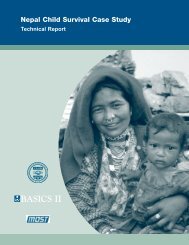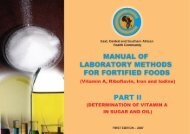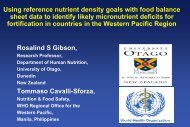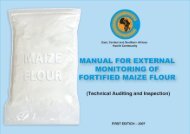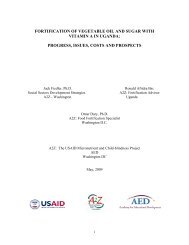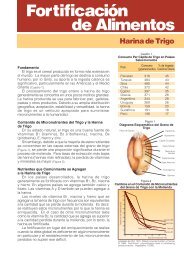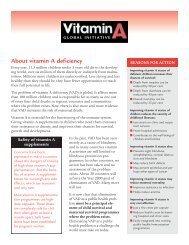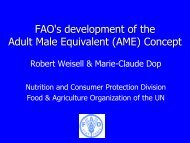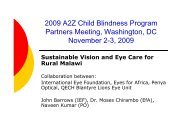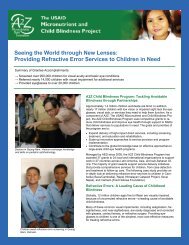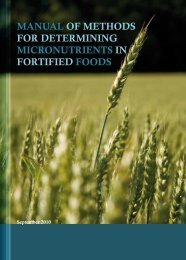SummarySummaryBackground, Objective, and MethodologyThis study was prepared under MOST, the USAID Micronutrient <strong>Program</strong>. Funded by theOffice <strong>of</strong> Health and Nutrition <strong>of</strong> the United States Agency <strong>for</strong> International Development(USAID), MOST is USAID’s flagship project <strong>for</strong> the promotion <strong>of</strong> activities to improve themicronutrient status <strong>of</strong> at-risk populations throughout the world.The study, which was conducted in April-May 2004, builds on a recent pilot wheat-flour<strong>for</strong>tification program in <strong>Bangladesh</strong>. Per<strong>for</strong>med through MOST <strong>for</strong> USAID/Dhaka, the pilotprogram was a limited-term project to improve vitamin A and iron status and also to reduceanemia through consumption <strong>of</strong> <strong>for</strong>tified wheat flour with vitamin A, iron, zinc, B1, B2, niacin,and folic acid.This study’s primary objective is to identify major elements <strong>of</strong> a food-<strong>for</strong>tification strategy in<strong>Bangladesh</strong>, including micronutrient <strong>for</strong>mulation <strong>for</strong> the food vehicles identified as suitable <strong>for</strong><strong>for</strong>tification.Data were collected from available documents with relevance to the oil, wheat, and sugarindustries, and from extensive interviews with <strong>of</strong>ficials <strong>of</strong> the Government <strong>of</strong> <strong>Bangladesh</strong> (GOB)and other key personnel in Dhaka during a two-week visit to <strong>Bangladesh</strong>.Current Ef<strong>for</strong>ts to Reduce Micronutrient Deficiency in <strong>Bangladesh</strong><strong>Bangladesh</strong> has achieved considerable progress in reducing poverty, child mortality, andmalnutrition. Despite these improvements, however, poverty remains alarmingly high, andthe overall level <strong>of</strong> child malnutrition remains one <strong>of</strong> the highest in the world. Only 32 percent<strong>of</strong> the population meet calorie requirements, 46 percent meet protein requirements, and 25percent meet fat requirements. Intake is low <strong>for</strong> most micronutrients, vitamin A indicators <strong>for</strong>children and women indicate the presence <strong>of</strong> a serious public health problem, and anemia iswidespread among all population groups.<strong>Bangladesh</strong> regards improved nutrition as a top government priority. Ongoing programsto reduce micronutrient deficiency include dietary diversification and other food-basedinterventions such as development <strong>of</strong> home gardens, poultry, fisheries, and other small farmanimals at the community level; salt iodization; and universal vitamin A supplementation <strong>for</strong>young children and lactating women.<strong>Food</strong> <strong>for</strong>tification was initiated with the implementation <strong>of</strong> a pilot wheat-flour <strong>for</strong>tificationactivity. Building on that initiative, the GOB has launched an ef<strong>for</strong>t to examine the suitability<strong>of</strong> other food-<strong>for</strong>tification vehicles. As a result <strong>of</strong> these interventions, it is expected thatfood-<strong>for</strong>tification will soon become an important element <strong>of</strong> the country’s strategy to reducemicronutrient malnutrition.ivMOST The USAID Micronutrient <strong>Program</strong>
Summary<strong>Elements</strong> <strong>of</strong> a <strong>National</strong> <strong>Food</strong>-<strong>Fortification</strong> <strong>Program</strong><strong>Food</strong> Vehicles and <strong>Fortification</strong> RegimeThis study considered three food<strong>for</strong>tificationvehicles: oil, wheat flour,and sugar. The suitability <strong>of</strong> each is brieflysummarized below.OilOil is a most suitable food-<strong>for</strong>tification vehiclein <strong>Bangladesh</strong>. Mustard-seed oil, soybean oil,and palm oil are the country’s three majorsources <strong>of</strong> edible oil. Since mustard-seed oilis not suitable <strong>for</strong> <strong>for</strong>tification, however, the<strong>for</strong>tification program should concentrate onsoybean and palm oils. Right now, per capitaconsumption <strong>of</strong> both these oils is adequateand rapidly increasing. For example, percapita consumption increased from 10g/dayin 1999-2000, to 14g/day on average between2000-2001 and 2002-2003, and was as high as17g/day in 2000-2002. Fortified at a minimumvitamin A level <strong>of</strong> 20mg/kg, consumption <strong>of</strong>13g/day/person <strong>of</strong> oil would supply morethan 50 percent <strong>of</strong> the estimated averagerequirement (EAR).At Tk 223, or $3.85 per metric ton (MT),oil has the lowest <strong>for</strong>tification cost amongthe three commodities considered — about20 percent below wheat-flour <strong>for</strong>tificationcost and well below sugar-<strong>for</strong>tification cost.In addition, total <strong>for</strong>tification costs, includingvitamin A, are estimated at 0.46 percent <strong>of</strong>retail price <strong>for</strong> oil (0.43 percent <strong>for</strong> soybean oiland 0.53 percent <strong>for</strong> palm oil) — suggestingthat oil <strong>for</strong>tification will not have anymeaningful impact on consumption.These cost estimates do not include the47 percent import duty currently imposedon micronutrients. Taking the importtax into consideration raises the costs<strong>of</strong> oil <strong>for</strong>tification to $5.62/MT, with acorresponding increase in retail prices. Thesame conclusion applies to wheat flour andoil, suggesting that elimination <strong>of</strong> the importduty on micronutrients should be considered.Soybean oil and palm oil are imported inan unrefined <strong>for</strong>m. These imports are thenprocessed by a limited number <strong>of</strong> producers.Of the 15 active oil producers in <strong>Bangladesh</strong>,3 have an individual capacity <strong>of</strong> over 1,000MT/day and process 80-90 percent <strong>of</strong> allsoybean and palm oil imports. Both the sizeand limited number <strong>of</strong> producers suggest thatmandatory <strong>for</strong>tification <strong>for</strong> oil would be themost-effective strategy.Wheat FlourWheat flour is a suitable food-<strong>for</strong>tificationvehicle in <strong>Bangladesh</strong>. The structure <strong>of</strong> themilling industry suggests that the wheat-flour<strong>for</strong>tification program should rely on rollermills rather than on chakki mills (small stonemills). It should also be private-sector drivenand voluntary.Per capita wheat-flour consumption isestimated at 43g/day. <strong>Fortification</strong> <strong>of</strong> wheatflour would supply about 20 percent <strong>of</strong> EAR<strong>for</strong> vitamin A, iron, folate, B-12, B-1, B-2, B-6,niacin, and zinc.<strong>Fortification</strong> costs <strong>for</strong> wheat flour are aboutTk295, or $5 per MT, and represent about 1.6percent <strong>of</strong> retail prices, suggesting that theadditional cost <strong>of</strong> <strong>for</strong>tification does not appearprohibitive to consumers.SugarStrong evidence presented in this studysuggests that sugar <strong>for</strong>tification in <strong>Bangladesh</strong>is not recommended. Because the bulk <strong>of</strong>sugar consumed is imported in an alreadyrefined <strong>for</strong>m, it places severe limitations onthe amount <strong>of</strong> sugar available <strong>for</strong> <strong>for</strong>tification.Local production is only about 20-25 percent<strong>of</strong> total sugar consumption, equivalent toless than 2g/day/person. Per capita sugarconsumption in rural areas, where most <strong>of</strong>the vulnerable groups can be found, is evenlower.At about Tk630, or $10.8 per MT, the cost<strong>of</strong> sugar <strong>for</strong>tification is over twice as high asthat <strong>for</strong> wheat flour and nearly three timesthat <strong>for</strong> oil. The additional cost associated<strong>Elements</strong> <strong>of</strong> a <strong>National</strong> <strong>Food</strong>-<strong>for</strong>tification <strong>Program</strong> <strong>for</strong> <strong>Bangladesh</strong>v


